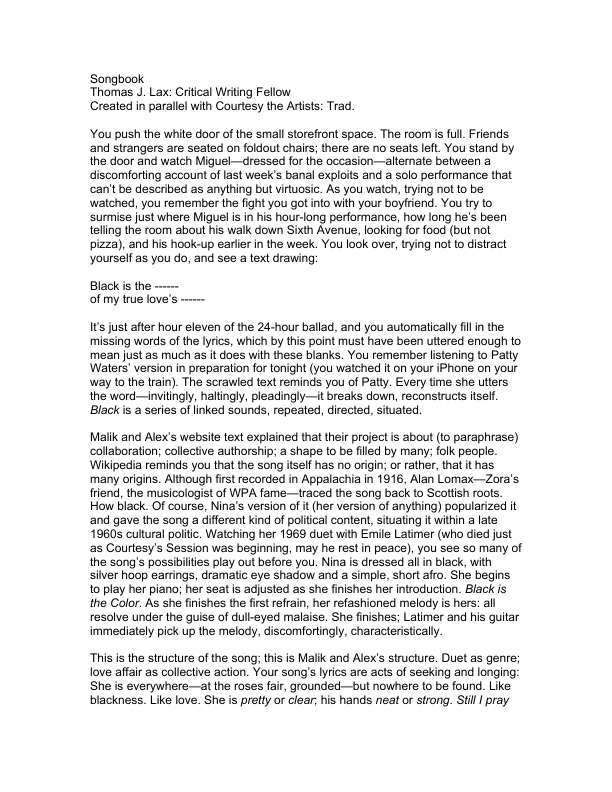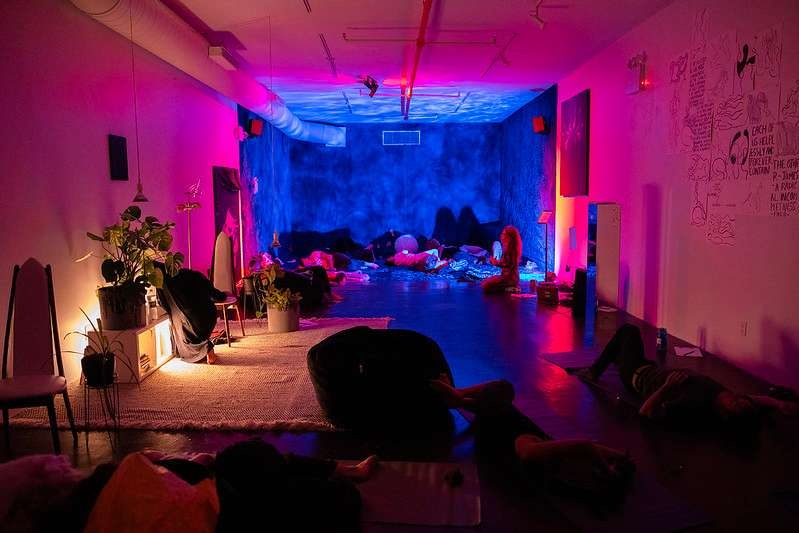You push the white door of the small storefront space. The room is full. Friends and strangers are seated on foldout chairs; there are no seats left. You stand by the door and watch Miguel—dressed for the occasion—alternate between a discomforting account of last week’s banal exploits and a solo performance that can’t be described as anything but virtuosic. As you watch, trying not to be watched, you remember the fight you got into with your boyfriend. You try to surmise just where Miguel is in his hour-long performance, how long he’s been telling the room about his walk down Sixth Avenue, looking for food (but not pizza), and his hook-up earlier in the week. You look over, trying not to distract yourself as you do, and see a text drawing:
Black is the ——
of my true love’s ——
It’s just after hour eleven of the 24-hour ballad, and you automatically fill in the missing words of the lyrics, which by this point must have been uttered enough to mean just as much as it does with these blanks. You remember listening to Patty Waters’ version in preparation for tonight (you watched it on your iPhone on your way to the train). The scrawled text reminds you of Patty. Every time she utters the word—invitingly, haltingly, pleadingly—it breaks down, reconstructs itself. Black is a series of linked sounds, repeated, directed, situated.
Malik and Alex’s website text explained that their project is about (to paraphrase) collaboration; collective authorship; a shape to be filled by many; folk people. Wikipedia reminds you that the song itself has no origin; or rather, that it has many origins. Although first recorded in Appalachia in 1916, Alan Lomax—Zora’s friend, the musicologist of WPA fame—traced the song back to Scottish roots. How black. Of course, Nina’s version of it (her version of anything) popularized it and gave the song a different kind of political content, situating it within a late 1960s cultural politic. Watching her 1969 duet with Emile Latimer (who died just as Courtesy’s Session was beginning, may he rest in peace), you see so many of the song’s possibilities play out before you. Nina is dressed all in black, with silver hoop earrings, dramatic eye shadow and a simple, short afro. She begins to play her piano; her seat is adjusted as she finishes her introduction. Black is the Color. As she finishes the first refrain, her refashioned melody is hers: all resolve under the guise of dull-eyed malaise. She finishes; Latimer and his guitar immediately pick up the melody, discomfortingly, characteristically.
This is the structure of the song; this is Malik and Alex’s structure. Duet as genre; love affair as collective action. Your song’s lyrics are acts of seeking and longing: She is everywhere—at the roses fair, grounded—but nowhere to be found. Like blackness. Like love. She is pretty or clear; his hands neat or strong. Still I pray that the time will come, when He and I will be as one; When She and I will be as one; When You and I will be as one. Here, he can be she can be you can be you.
You stay. Just one more hour after another, like an all-night TV marathon. The evocations of loving blackness or black emptiness range: American Westerns (Bassichis) and butoh (Martohardjono). This 24-Hour Ballad was the equinox of Courtesy the Artist’s Recess Session, occurring after Night Music, the performance of supernatural folk songs alongside scary stories; as well as father/father-in-law Charles Gaines’ performance with Liudni Slibinai. Much like My Barbarian’s (Malik plus Alex plus the inimitable Jade Gordon) reinhabitation of Southern Californian New Age 70s culture, Courtesy the Artists reanimates the cultural politics of past moments. Trad. is the duo’s second project since their moving to and founding in New York. Last fall, they organized The Meeting, to which they invited performers to interpret songs from Black Panther Party leader Elaine Brown’s short, impactful and agitprop album Seize The Time (1968). Like the moniker from which they derive their name, Malik and Alex’s 1-year old duo takes on a curatorial role, inviting artists and collectives to contribute.
The following songbook below takes on their ethos, inviting several audience members to reflect on the performances they experienced during the ballad in 140-character responses, which the writers interpreted with some variation.Readers are welcome to send submissions for additional hours to thomas.lax@gmail.com.
12:00 PM Alexandro Segade
1:00 PM Gregg Bordowitz Black is the color of my extravagant abjection, my elective affinity, my electric avenue, my early atmosphere, my earthly aporia, my easy A.
—Tavia Nyongo, Dec. 3, 2013
2:00 PM Tavia Nyong’o
3:00 PM Jeanine Oleson
Voices Professional Amateur Play
Melody Movement Bodies Trade Places
Walls Opposites Attraction Repulsion
Embarrassment Defeats Hierarchies
—Gregg Bordowitz, Dec. 17, 2013
4:00 PM Saya Woolfalk
5:00 PM Quincy Flowers
6:00 PM Zach Layton
7:00 PM Matana Roberts
black is the color of my true love’s hair
is homage is
statement is
political
gesture and
community
lamentation
to be young gifted and black
is mantra and
song
reflection as
meditation
and memory
matana
talked, sang, look inwardly and outwardly
entranced
enraged
enthralled
exhausted
matana was defiant
was resigned
was empowered
was crying
she was
no matter what people make
humming
rhythmical tapping
jazzing
sighing
silence
you see what happened there?
matana played and lived and breathed
for all, to all, against all
when
she and all will be as one
—Carlos Motta, Dec. 10, 2013
8:00 PM niv acosta
I remember niv as toddler at piano, his feet cannot reach the pedals but he plays anyway, then niv as teenager with a drum set, giving it an adolescent thump. Adult niv smartly recording us as we talk and cough and then playing it back so we can hear ourselves seeing, then niv of no age dancing new age semaphores through blue smoke. We all grew up.
He takes a sip from the half-full bottle of bourbon on top of the upright piano. “Black is the color of my true love’s hair,” but niv’s hair is hidden under a hat and I still have to account for my feelings of love. A vogueing look pierces me, and a hand, palm faced out, slices though the lingering echo of Matana Roberts’ voice. Other ghosts, bodies, genders bubble up through his fluid choreography: Willi Ninja and William Forstyhe, Nina Simone and niv, niv, niv.
—Brennan Gerard, Dec. 6, 2013
9:00 PM Sara Magenheimer
10:00 PM Christine Sun Kim Christine Sun Kim’s lively rendition of “Black is the Color” enlisted the audience’s participation to explore the relationship between vocal and visual languages. Separating the song’s lyrics from its musical notation, the artist created her own score that was passed from person-to-person on strips of blank paper. “BBBB-LLLL-AAAA-CCCC-KKKK” could be vocalized through the repetition of letters or the elision of sounds. The sounding of these linguistic permutations facilitated a physical experience of rhythm and melody. The artist’s exuberant direction set the tone, backed by whiskey pours (as opposed to music accompaniment) warmed the room. The near-hour-long performance wrapped on a high note with a comically protracted score of the entire song. As the long, continuous scroll passed through the hands (and voices) of sixty plus in attendance, Sun Kim carried the room in song, by the end, leaving everyone breathless.
—Ryan Inouye, Dec. 11, 2013
11:00 PM Miguel Gutierrez See? Score for foolproof performance: Hasty charm + gallant stranger. Helps if you speak French, as usual.
—David Velasco, Dec. 20, 2013
12:00 AM Sam Greenleaf Miller & Katy Pyle
1:00 AM Paul Mpagi Sepuya Photographer Paul Mpagi Sepuya’s first-ever performance work was a collaborative affair. Paul called upon viewers to announce names of intimates, which he used to replace the lover’s name of the Richard Bruce Nugent novel he read aloud. The interchangeability of this object of affection resonated with the anonymous, open-ended muse of “Black is the Color of My True Love’s Hair.”
Paper print-outs of Paul’s photographs were strewn about, which he encouraged us to compile into a chapter. I am a heartfelt fan of Paul’s “SOME RECENT PICTURES / a journal” (2013), a unique artist book that bears the markings of his edits and erasures. Feeling my own way –tactilely, visually, emotionally– through Paul’s images was a curatorial treat. It was 1 am, and Paul provided whiskey; resultantly, my arrangement focused on a topic that seems to always catch both my and Paul’s eyes: sweet boys looking sweet.
—Alex Fialho, Dec. 15, 2013
2:00 AM Joshua Seidner
3:00 AM Hiroshi McDonald Mori
4:00 AM Zavé Martohardjono
5:00 AM Charles Gaines
6:00 AM Nick Hallett
7:00 AM Jessica Posner
8:00 AM Morgan Bassichis
9:00 AM Marina Rosenfeld
10:00 AM Vishal Jugdeo
About the artist
Explore/Archive
See allDecember 2025
The INSTITUTE FOR TRANSHUMANIST CEPHALOPOD EVOLUTION and Learning from Octopuses
Barbara London
Barbara London reflect's of Miriam SImun's INSTITUTE FOR TRANSHUMANIST CEPHALOPOD EVOLUTION
October 2025
streamlined reflections, courtesy of noise canceling headphones
Gabrielle Rucker
Gabrielle Rucker reflects on the radical intimacy and auditory life at the heart of Deli Radio
July 2025
Tell My Jockey: CUNTRY’s Discourse From the Horse’s Mouth
Ericka Pérez
Assembly fellow Ericka Pérez reflects on clowning, resistance, and CUNTRY’s radical refusal to perform.







